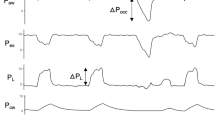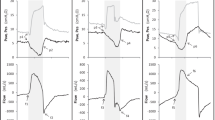Abstract
Purpose
This study introduces a method to non-invasively and automatically quantify respiratory muscle effort (Pmus) during mechanical ventilation (MV). The methodology hinges on numerically solving the respiratory system’s equation of motion, utilizing measurements of airway pressure (Paw) and airflow (Faw). To evaluate the technique’s effectiveness, Pmus was correlated with expected physiological responses. In volume-control (VC) mode, where tidal volume (VT) is pre-determined, Pmus is expected to be linked to Paw fluctuations. In contrast, during pressure-control (PC) mode, where Paw is held constant, Pmus should correlate with VT variations.
Methods
The study utilized data from 250 patients on invasive MV. The data included detailed recordings of Paw and Faw, sampled at 31.25 Hz and saved in 131.1-second epochs, each covering 34 to 41 breaths. The algorithm identified 51,268 epochs containing breaths on either VC or PC mode exclusively. In these epochs, Pmus and its pressure-time product (PmusPTP) were computed and correlated with Paw’s pressure-time product (PawPTP) and VT, respectively.
Results
There was a strong correlation of PmusPTP with PawPTP in VC mode (R² = 0.91 [0.76, 0.96]; n = 17,648 epochs) and with VT in PC mode (R² = 0.88 [0.74, 0.94]; n = 33,620 epochs), confirming the hypothesis. As expected, negligible correlations were observed between PmusPTP and VT in VC mode (R² = 0.03) and between PmusPTP and PawPTP in PC mode (R² = 0.06).
Conclusion
The study supports the feasibility of assessing respiratory effort during MV non-invasively through airway signal analysis. Further research is warranted to validate this method and investigate its clinical applications.




Similar content being viewed by others
Data availability
The datasets used and analyzed during the current study can be found in the Electronic Data Repository. The database storing the raw data is available from the author upon reasonable request.
References
Slutsky AS, Ranieri VM. (2013) Ventilator-induced lung injury. N Engl J Med. 369:2126–2136,. doi: 10.1056/NEJMra1208707. Erratum in: N Engl J Med. 370:1668–1669, 2014. PMID: 24283226.
Marini JJ, Rocco PRM, Gattinoni L. Static and dynamic contributors to ventilator-induced Lung Injury in Clinical Practice. Pressure, Energy, and Power. Am J Respir Crit Care Med. 2020;201:767–74. https://doi.org/10.1164/rccm.201908-1545CI. PMID: 31665612; PMCID: PMC7124710.
Demoule A, Hajage D, Messika J, Jaber S, Diallo H, Coutrot M, Kouatchet A, Azoulay E, Fartoukh M, Hraiech S, Beuret P, Darmon M, Decavèle M, Ricard JD, Chanques G, Mercat A, Schmidt M, Similowski T, REVA Network (Research Network in Mechanical Ventilation). (2022) Prevalence, Intensity, and Clinical Impact of Dyspnea in Critically Ill Patients Receiving Invasive Ventilation. Am J Respir Crit Care Med. 205:917–926. https://doi.org/10.1164/rccm.202108-1857OC. PMID: 35061577.
Worsham CM, Banzett RB, Schwartzstein RM. Dyspnea, Acute Respiratory failure, psychological trauma, and Post-ICU Mental Health: a caution and a call for Research. Chest. 2021;159:749–56. https://doi.org/10.1016/j.chest.2020.09.251. Epub 2020 Oct 1. PMID: 33011205; PMCID: PMC7528739.
Rohrer F. Der Zusammenhang Der Atemkräfte und ihre Abhängigkeit Vom Dehnungszustand Der Atmungsorgane. Pflüger’s Arch. 1916;165:419–44. https://doi.org/10.1007/BF01681079.
Otis A, Fenn W, Rahn H. (1950) Mechanics of breathing in man. J Appl Physiol. 2:592–607. doi: 10.1152/jappl.1950.2.11.592. PMID: 15436363.
Rossi A, Gottfried SB, Higgs BD, Zocchi L, Grassino A, Milic-Emili J. (1985) Respiratory mechanics in mechanically ventilated patients with respiratory failure. J Appl Physiol 58:1849–1858. https://doi.org/10.1152/jappl.1985.58.6.1849. PMID: 4008405.
Gutierrez G. A novel method to calculate compliance and airway resistance in ventilated patients. Intensive Care Med Exp. 2022;10:55. https://doi.org/10.1186/s40635-022-00483-2. PMID: 36581716; PMCID: PMC9800666.
Gutierrez G, Ballarino GJ, Turkan H, Abril J, De La Cruz L, Edsall C, George B, Gutierrez S, Jha V, Ahari J. Automatic detection of patient-ventilator asynchrony by spectral analysis of airway flow. Crit Care. 2011;15:R167. https://doi.org/10.1186/cc10309. PMID: 21749683; PMCID: PMC3387605.
Gutierrez G, Williams J, Alrehaili GA, McLean A, Pirouz R, Amdur R, Jain V, Ahari J, Bawa A, Kimbro S. Respiratory rate variability in sleeping adults without obstructive sleep apnea. Physiol Rep. 2016;4:e12949. https://doi.org/10.14814/phy2.12949. PMID: 27597768; PMCID: PMC5027356.
Rossi A, Gottfried SB, Zocchi L, Higgs BD, Lennox S, Calverley PM, Begin P, Grassino A, Milic-Emili J. (1985) Measurement of static compliance of the total respiratory system in patients with acute respiratory failure during mechanical ventilation. The effect of intrinsic positive end-expiratory pressure. Am Rev Respir Dis 131:672–677. https://doi.org/10.1164/arrd.1985.131.5.672. PMID: 4003913.
Brochard L. Intrinsic (or auto-) PEEP during controlled mechanical ventilation. Intensive Care Med. 2002;28:1376–8. https://doi.org/10.1007/s00134-002-1438-8.
Servillo G, Svantesson C, Beydon L, Roupie E, Brochard L, Lemaire F, Jonson B. Pressure–volume curves in acute respiratory failure: automated low flow inflation versus occlusion. Am J Respir Crit Care Med. 1997;155:1629–36. https://doi.org/10.1164/ajrccm.155.5.9154868.
Rousseeuw PJ, Hubert M. Anomaly detection by robust statistics WIREs. Data Min Knowl Discov. 2018;8:e1236. https://doi.org/10.1002/widm.1236.
Akoumianaki E, Lyazidi A, Rey N, Matamis D, Perez-Martinez N, Giraud R, Mancebo J, Brochard L, Richard JM. (2013) Mechanical ventilation-induced reverse-triggered breaths: a frequently unrecognized form of neuromechanical coupling. Chest. 143:927–938. https://doi.org/10.1378/chest.12-1817. PMID: 23187649.
Jonkman AH, Telias I, Spinelli E, Akoumianaki E, Piquilloud L. The oesophageal balloon for respiratory monitoring in ventilated patients: updated clinical review and practical aspects. Eur Respir Rev. 2023;32:220186. https://doi.org/10.1183/16000617.0186-2022. PMID: 37197768; PMCID: PMC10189643.
Mauri T, Yoshida T, Bellani G, Goligher EC, Carteaux G, Rittayamai N, Mojoli F, Chiumello D, Piquilloud L, Grasso S, Jubran A, Laghi F, Magder S, Pesenti A, Loring S, Gattinoni L, Talmor D, Blanch L, Amato M, Chen L, Brochard L, Mancebo J. PLeUral pressure working Group (PLUG—Acute Respiratory Failure section of the European Society of Intensive Care Medicine) (2016) Esophageal and transpulmonary pressure in the clinical setting: meaning, usefulness and perspectives. Intensive Care Med. 42:1360–1373. https://doi.org/10.1007/s00134-016-4400-x. PMID: 27334266.
Jubran A, Van de Graaff WB, Tobin MJ. (1995) Variability of patient-ventilator interaction with pressure support ventilation in patients with chronic obstructive pulmonary disease. Am J Respir Crit Care Med. 152:129–136. https://doi.org/10.1164/ajrccm.152.1.7599811. PMID: 7599811.
Archie JP Jr. Mathematic coupling of data: a common source of error. Ann Surg. 1981;193:296–303. https://doi.org/10.1097/00000658-198103000-00008. PMID: 7212790; PMCID: PMC1345065.
Carteaux G, Parfait M, Combet M, Haudebourg AF, Tuffet S, Mekontso Dessap A. Patient-self inflicted Lung Injury: a practical review. J Clin Med. 2021;10:2738. https://doi.org/10.3390/jcm10122738. PMID: 34205783; PMCID: PMC8234933.
Yoshida T, Nakahashi S, Nakamura MAM, Koyama Y, Roldan R, Torsani V, De Santis RR, Gomes S, Uchiyama A, Amato MBP, Kavanagh BP, Fujino Y. (2017) Volume-controlled Ventilation Does Not Prevent Injurious Inflation during Spontaneous Effort. Am J Respir Crit Care Med. 196:590–601. https://doi.org/10.1164/rccm.201610-1972OC. PMID: 28212050.
Acknowledgements
The author thanks the Commission for Educational Exchange between the United States, Belgium and Luxembourg and the Fulbright Scholarship Board. Their generous support as a Fulbright Research Scholar granted the author the time and resources necessary to develop the ideas that formed the basis of this research.
Author information
Authors and Affiliations
Contributions
Single author manuscript. I take responsibility for all aspects of the research.
Corresponding author
Ethics declarations
Competing interests
The author has applied for a U.S. patent based on the information presented in the manuscript.
Ethical approval and consent to participate
The database used in the present study was collected during the conduct of several IRB approved studies (Nos. 101228, 110910, 111235) at The George Washington University Hospital, with the IRB allowing the use of deidentified data in further studies.
Consent for publication
Not applicable.
Additional information
Publisher’s Note
Springer Nature remains neutral with regard to jurisdictional claims in published maps and institutional affiliations.
Electronic supplementary material
Below is the link to the electronic supplementary material.
Glossary
- Crs
-
Respiratory system static compliance
- ΔV(t)
-
Lung volume change during insufflation
- Faw
-
Airway flow
- PEEPa
-
Applied positive end expiratory pressure
- PEEPi
-
Intrinsic PEEP present at end expiration
- PC
-
Pressure control ventilation mode
- PS
-
Pressure support ventilation mode
- Paw
-
airway pressure
- PawPeak
-
Peak inspiratory pressure
- PawPTP
-
Paw pressure time product
- Pmus
-
Respiratory muscles pressure
- Peak_Pmus
-
Peak respiratory muscles pressure
- PmusPTP
-
Pmus pressure time product
- Ppassive
-
Paw required for passively inflation of the respiratory system
- rs
-
Respiratory system
- Rrs
-
Respiratory system inspiratory airway resistance
- RRVI
-
respiratory rate variability index
- VC
-
Volume control ventilation mode
- VT
-
Tidal volume
Rights and permissions
Springer Nature or its licensor (e.g. a society or other partner) holds exclusive rights to this article under a publishing agreement with the author(s) or other rightsholder(s); author self-archiving of the accepted manuscript version of this article is solely governed by the terms of such publishing agreement and applicable law.
About this article
Cite this article
Gutierrez, G. A non-invasive method to monitor respiratory muscle effort during mechanical ventilation. J Clin Monit Comput (2024). https://doi.org/10.1007/s10877-024-01164-z
Received:
Accepted:
Published:
DOI: https://doi.org/10.1007/s10877-024-01164-z




